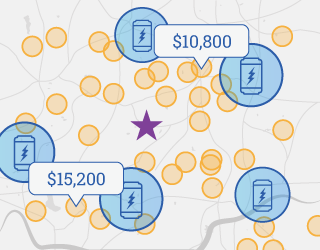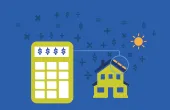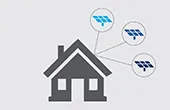In February 2021, Texas residents lost power after the state’s electrical grid failed as the catastrophic Winter Storm Uri moved through the state. A question remains whether or not there’s still legitimate cause for concern. Almost half of Texans (47 percent) don’t believe that the legislation passed improved the reliability of the state’s electrical grid sufficiently enough to help ensure that Texans will not again suffer as they did during the February 2021 winter storm.
Key takeaways
- Texas has a deregulated electricity market and relies heavily on natural gas production.
- The February 2021 storm killed at least 246 people and caused between $80 – $130 billion in damages. While the state legislature passed several bills in 2021 to address what happened, many Texans and industry experts still question if enough has been done and worry about the stability of the Texas electrical grid.
- Increasing reliance on clean energy can help build reliability into electric grids.
- Get options to keep powering your home even during an outage with solar-plus-storage on the EnergySage Marketplace.
What’s in this article?
- Overview of Texas’s deregulated electricity market
- What was the impact of the 2021 Texas blackouts?
- Has Texas made policy changes since the 2021 winter storm?
- What’s the status of the Texas grid in 2022?
- Do Texas electric grid issues remain?
- What more can be done to address the Texas grid concerns?
A quick overview of Texas’s deregulated electricity market
Texas has a deregulated electricity market, which means there is competition for separate companies to take on each part of the process of getting the electricity from power plants to your home. In states with regulated markets, a single utility company can carry out all parts of the process. The Public Utility Commission of Texas (PUC) regulates the Electric Reliability Council of Texas (ERCOT), which manages the electricity grid.
Nearly 90 percent of the state’s population depend on the ERCOT-managed grid for electricity services, though ERCOT does not have its own grid infrastructure. Texas does operate its own grid, which is separate from the rest of the country’s electrical system. (This actually contributed to the severity of the outages and prevented Texas from getting power from other sources during the winter 2021 storm.) Instead, Texans rely on power generation companies, electricity utilities like municipally-owned providers, and electric cooperatives.
Texas’s energy production breakdown is 51 percent natural gas, 24.8 percent wind, and 13.4 percent coal.
What was the impact of the 2021 Texas blackouts?
This storm was, in no uncertain terms, catastrophic. According to the Texas Tribune, an estimated 246 Texas residents (if not more, some sources cite higher fatalities) died across 77 counties during the February 2021 winter storm. Additionally, it severely damaged the economy, with rough estimations indicating damages between $80 – $130 billion in direct and indirect economic loss with insured losses estimated between $10 – $20 billion.
The North American Electric Reliability Corporation (NAERC) report on the event notes unprecedented electric generation outages to the point that the affected Balancing Authorities (BAs) declared energy emergencies and ordered blackouts to avoid total system blackouts. BAs are entities that ensure that energy demand and supply are finely balanced in real-time to maintain safe and reliable power system operations.
A survey by the University of Houston’s Hobby School of Public Affairs indicates that over two-thirds (69 percent) of Texans lost electricity at some point between February 14-20, 2021. The average outage lasted 42 hours. Additionally, almost half (49 percent) of Texans lost access to running water, with the average person losing it for 52 hours.
Check out this article to get our take on what caused the Texas blackouts in 2021.
Has Texas made policy changes since the 2021 winter storm?
After much attention on the Texas electrical grid, the state implemented several changes via legislation and leadership. Some key legislation passed by the 87th Legislature and signed by Texas Governor Greg Abbott following the February 2021 storm include bills addressing:
ERCOT board formation and oversight
Senate Bill (SB) 2 includes a requirement that ERCOT board members be residents of Texas (at the time of the February 2021 storm, five of the 16 board members didn’t reside in Texas).
Statewide alert system
SB 3 is a consolidation of several bills that didn’t pass on their own and forms a statewide alert system when the power supply is at risk. It also formalizes the Texas Energy Reliability Council (TERC), which must submit a report each legislative session on the state’s electricity supply chain status. This bill requires weatherization for electric generation facilities, transmission providers, certain natural gas facilities and pipelines, and water utilities.
Restrictions on electricity pricing
HB 16 places restrictions on electricity pricing under plans directly tied to the wholesale electricity spot price – the current price it’s being bought and sold at on the market. Under these plans, wholesale electricity prices will directly impact what you owe your utility, leading to extremely high bills when the grid is stressed. For example, the February 2021 storm left some customers (particularly those who have variable rate plans) with thousands of dollars in electricity bills.
For a full list of Texas electricity reform legislation that passed in 2021, check out this summary from the Texas Comptroller’s Office.
What’s the status of the Texas grid in 2022?
Winter storms moving through the country in February 2022 brought attention to Texas as some people worried about a repeat of last year’s disaster. The governor assured residents that the steps taken would keep Texans safe, though there was little proof to support those assurances. In press conferences, Texas officials also warned that there could still be some outages. Fortunately, there were no blackouts, but many experts say that the winter weather wasn’t extreme enough to confirm everything is better.
Do Texas electric grid issues remain?
Some Texans remain skeptical about the state of the Texas electrical grid, with key concerns still lingering. ERCOT’s own November 2021 assessment of the Texas grid was that it “would not be able to keep up with demand even under winter conditions less severe than what happened in February [2021].”
While the lights stayed on during the February 2022 cold front, several news outlets cited an S&P Global Report as cause for continued concern with the ability of the grid to perform in extreme weather conditions. The report showed an approximately 20 percent drop in natural gas production in the Permian Basin (Texas’s main natural gas production area) during the temperature drop.
There’s clear disapproval in how the state has responded to grid instability and unreliability concerns. A 2022 University of Houston survey shows only slightly over half of Texans (55 percent) believe the natural gas industry has carried out reforms to ease concerns about a loss of electrical power.
What more can be done to address the Texas grid concerns?
Decreasing Texas’s reliability on natural gas and increasing reliability on clean energy solutions can help overall grid reliability. A majority of Texans surveyed do favor expanding reliance on clean energy: 65 percent support expansion with solar and geothermal power plants, 58 percent with hydrogen power plants, 56 percent with wind turbine farms, and 55 percent with hydroelectric dams.
Other actionable steps include retrofitting dated equipment and continuing to weatherize equipment. The Federal Energy Regulatory Commission’s (FERC) final report on the February 2021 event calls out some recommendations, including retrofitting existing generating units and performing annual training on winterization plans. However, retrofitting old equipment is a pretty costly task.
And while you can’t personally make system-wide changes, voting for candidates focused on sustainable, renewable energy solutions is one way to help make this happen. You can see how your current representatives stack up when it comes to clean energy support on the National Environmental Scorecard.
Energy storage provides resiliency
In the event of an outage, energy storage systems provide emergency backup power – meaning you don’t have to worry about losing power to your most essential devices. Some energy storage systems can even be designed to provide full home backup power so you can essentially continue powering your whole home throughout an outage. For example, the Generac PWRcell can be coupled with the PWRgenerator – the first generator of its kind designed to recharge an energy storage system directly – and the PWRmanager – an energy management system – to easily provide whole-home power. Similarly, the Enphase IQ can be configured for a Full Energy Independence setup.
Protect yourself during outages with solar-plus-storage
Whether you live in Texas or another state, the reality is that you can power your own home with solar-plus-storage for less reliance on the electrical grid and protection from outages. Get peace of mind knowing that you’ll have power even when the grid goes dark by signing up for a free account on EnergySage and checking out solar-plus-storage options in your area. (Be sure to take a look at what incentives you’ll be eligible for in Texas or wherever you live to make going solar even more affordable!)






